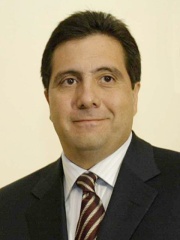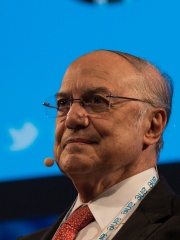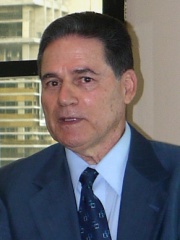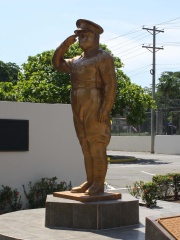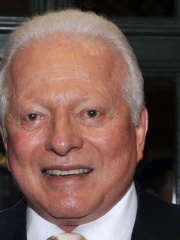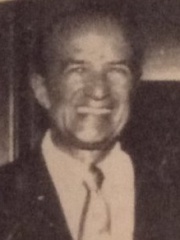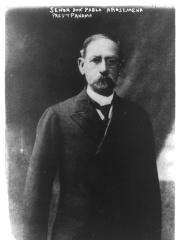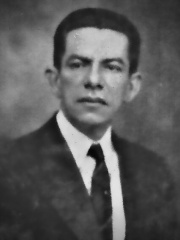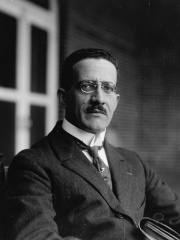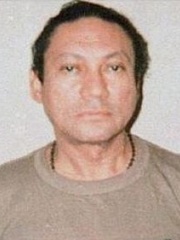
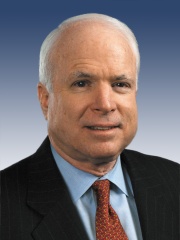
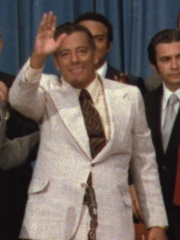
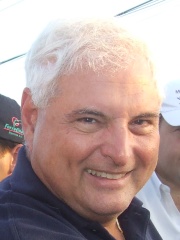
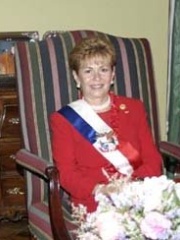
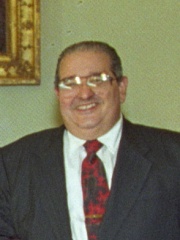
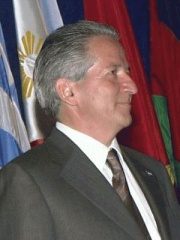
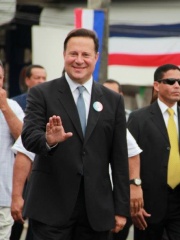
The Most Famous
POLITICIANS from Panama
This page contains a list of the greatest Panamanian Politicians. The pantheon dataset contains 19,576 Politicians, 19 of which were born in Panama. This makes Panama the birth place of the 110th most number of Politicians behind Guinea-Bissau, and Tanzania.
Top 10
The following people are considered by Pantheon to be the top 10 most legendary Panamanian Politicians of all time. This list of famous Panamanian Politicians is sorted by HPI (Historical Popularity Index), a metric that aggregates information on a biography's online popularity. Visit the rankings page to view the entire list of Panamanian Politicians.

1. Manuel Noriega (1934 - 2017)
With an HPI of 73.80, Manuel Noriega is the most famous Panamanian Politician. His biography has been translated into 60 different languages on wikipedia.
Manuel Antonio Noriega Moreno ( mahn-WEL NOR-ee-AY-gə, Spanish: [maˈnwel noˈɾjeɣa]; February 11, 1934 – May 29, 2017) was a Panamanian dictator and military officer who was the de facto ruler of Panama from 1983 to 1989. He never officially served as president of Panama, instead ruling as an unelected military dictator through puppet presidents. Amassing a personal fortune through drug trafficking operations by the Panamanian military, Noriega had longstanding ties with American intelligence agencies before the U.S. invasion of Panama removed him from power. Born in Panama City to a poor pardo family, Noriega studied at the Chorrillos Military School in Lima and at the School of the Americas. He became an officer in the Panamanian army, and rose through the ranks in alliance with Omar Torrijos. In 1968, Torrijos overthrew President Arnulfo Arias in a coup. Noriega became chief of military intelligence in Torrijos's government and, after Torrijos's death in 1981, consolidated power to become Panama's de facto ruler in 1983. Beginning in the 1950s, Noriega worked with U.S. intelligence agencies, and became one of the Central Intelligence Agency's most valued intelligence sources. He also served as a conduit for illicit weapons, military equipment, and cash destined for U.S.-backed forces throughout Latin America. Noriega's relationship with the U.S. deteriorated in the late 1980s after the murder of Hugo Spadafora and the forced resignation of President Nicolás Ardito Barletta. Eventually, his relationship with intelligence agencies in other countries came to light, and his involvement in drug trafficking was investigated further. In 1988, Noriega was indicted by federal grand juries in Miami and Tampa on charges of racketeering, drug smuggling, and money laundering. The U.S. launched an invasion of Panama following failed negotiations seeking his resignation, and Noriega's annulment of the 1989 Panamanian general election. Noriega was captured and flown to the U.S., where he was tried on the Miami indictment, convicted on most of the charges, and sentenced to 40 years in prison, ultimately serving 17 years after a reduction in his sentence for good behavior. Noriega was extradited to France in 2010, where he was convicted and sentenced to seven years of imprisonment for money laundering. In 2011 France extradited him to Panama, where he was incarcerated for crimes committed during his rule, for which he had been tried and convicted in absentia in the 1990s. Diagnosed with a brain tumor in March 2017, Noriega suffered complications during surgery, and died two months later. Noriega's dictatorship was marked by repression of the media, an expansion of the military, and the persecution of political opponents, effectively controlling the outcomes of any elections. He relied upon military nationalism to maintain his support, and did not espouse a specific social or economic ideology. Noriega was known for his complicated relationship with the U.S., and was described as being its ally and adversary simultaneously.

2. John McCain (1936 - 2018)
With an HPI of 73.79, John McCain is the 2nd most famous Panamanian Politician. His biography has been translated into 107 different languages.
John Sidney McCain III (August 29, 1936 – August 25, 2018) was an American politician and naval officer who represented Arizona in the United States Congress for over 35 years, first as a U.S. representative from 1983 to 1987, then as a U.S. senator from 1987 until his death in 2018. A member of the Republican Party, he was the party's nominee in the 2008 presidential election. Born into the prominent McCain family in the Panama Canal Zone, McCain graduated from the U.S. Naval Academy in 1958 and received a commission in the U.S. Navy. He became a naval aviator and flew ground-attack aircraft from aircraft carriers. During the Vietnam War, he almost died in the 1967 USS Forrestal fire. While on a bombing mission during Operation Rolling Thunder over Hanoi in October 1967, McCain was shot down, seriously injured, and captured by the North Vietnamese. He was a prisoner of war until 1973. McCain experienced episodes of torture and refused an out-of-sequence early release. He sustained wounds that left him with lifelong physical disabilities. McCain retired from the Navy as a captain in 1981 and moved to Arizona. In 1982, McCain was elected to the House of Representatives, where he served two terms. Four years later, he was elected to the Senate, where he served six terms. While generally adhering to conservative principles, McCain also gained a reputation as a "maverick" for his willingness to break from his party on certain issues, including LGBT rights, gun regulations, and campaign finance reform where his stances were more moderate than those of the party's base. McCain was investigated and largely exonerated in a political influence scandal of the 1980s as one of the Keating Five. He then made regulating the financing of political campaigns one of his signature concerns, which eventually resulted in the passage of the McCain–Feingold Act in 2002. With Russ Feingold, McCain would receive the 1999 John F. Kennedy Profile in Courage Award. He was also known for his work in the 1990s to restore diplomatic relations with Vietnam. McCain chaired the Senate Commerce Committee from 1997 to 2001 and 2003 to 2005, where he opposed pork barrel spending and earmarks. He belonged to the bipartisan "Gang of 14", which played a key role in alleviating a crisis over judicial nominations. McCain entered the race for the 2000 Republican presidential nomination, but lost a heated primary season contest to George W. Bush. He secured the 2008 Republican presidential nomination, beating fellow candidates Mitt Romney and Mike Huckabee, though he lost the general election to Barack Obama. McCain subsequently adopted more orthodox conservative stances and attitudes and largely opposed actions of the Obama administration, especially with regard to foreign policy matters. In 2015, he became Chairman of the Senate Armed Services Committee. He refused to support Donald Trump in the 2016 presidential election and later became a vocal critic of the first Trump administration. While McCain opposed the Obama-era Affordable Care Act (ACA), he cast the deciding vote against the American Health Care Act of 2017, which would have partially repealed the ACA. After being diagnosed with glioblastoma in 2017, he reduced his role in the Senate to focus on treatment, dying from the disease in 2018.

3. Omar Torrijos (1929 - 1981)
With an HPI of 68.76, Omar Torrijos is the 3rd most famous Panamanian Politician. His biography has been translated into 39 different languages.
Omar Efraín Torrijos Herrera (February 13, 1929 – July 31, 1981) was the Panamanian military leader of Panama, as well as the Commander of the Panamanian National Guard from 1968 to his death in 1981. Torrijos was never officially the president of Panama, but instead held self-imposed and all-encompassing titles including "Maximum Leader of the Panamanian Revolution". Torrijos took power in a coup d'état and instituted a number of social reforms. Torrijos is best known for negotiating the 1977 Torrijos–Carter Treaties that eventually gave Panama full sovereignty over the Panama Canal. The two treaties guaranteed that Panama would gain control of the Panama Canal after 1999, ending the control of the canal that the U.S. had exercised since 1903. On December 31, 1999, the final phase of the treaty, the US relinquished control of the Panama Canal and all areas in what had been the Panama Canal Zone. His son Martín Torrijos was president from 2004 to 2009.

4. Ricardo Martinelli (b. 1952)
With an HPI of 62.92, Ricardo Martinelli is the 4th most famous Panamanian Politician. His biography has been translated into 44 different languages.
Ricardo Alberto Martinelli Berrocal (born 11 March 1951) is a Panamanian politician and businessman who served as the 36th President of Panama from 2009 to 2014. In 2024, Martinelli was sentenced to ten years in prison for embezzlement of public funds and money laundering related to his use of public money to buy several Panamanian media outlets in 2010. He was implicated in several other corruption cases during his presidency (Odebrecht, New Business, Financial Pacific, Blue Apple, among others); as of February 2024, he is facing several trials.
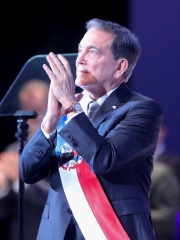
5. Laurentino Cortizo (b. 1953)
With an HPI of 62.89, Laurentino Cortizo is the 5th most famous Panamanian Politician. His biography has been translated into 36 different languages.
Laurentino "Nito" Cortizo Cohen (Spanish pronunciation: [lawɾenˈtino koɾˈtiso ˈko.en]; born 30 January 1953) is a Panamanian politician who served as the 38th President of Panama from 2019 to 2024. Previously, he served as President of the National Assembly (2000–2001) and Minister of Agricultural and Livestock Development (2004–2006). Cortizo was a member of the National Assembly for Colón Province from 1994 to 2004. A member of the Democratic Revolutionary Party, he was elected as president in the 2019 general election, winning 33.27% of the vote. He took office on 1 July 2019.

6. Mireya Moscoso (b. 1946)
With an HPI of 62.10, Mireya Moscoso is the 6th most famous Panamanian Politician. Her biography has been translated into 38 different languages.
Mireya Elisa Moscoso Rodríguez (born 1 July 1946) is a Panamanian politician who served as the President of Panama from 1999 to 2004. She is the country's first and to date only female president. Born into a rural family, Moscoso became active in the 1968 presidential campaign of three-time president Arnulfo Arias, following and marrying him when he went into exile after a military coup. After his death in 1988, she assumed control of his coffee business and later his political party, the Arnulfista Party (PA). During the 1994 general elections for the presidency, she narrowly lost to the Democratic Revolutionary Party (PRD) candidate Ernesto Pérez Balladares by 4% of the vote. In the 1999 general election, she defeated the PRD candidate Martín Torrijos by 7% to become Panama's first female president. During her tenure in office, she presided over the handover of the Panama Canal from the US to Panama and the economic downturn that resulted from the loss of US personnel. Hobbled by new spending restrictions passed by the opposition-controlled Legislative Assembly, and her administration's corruption scandals, she had difficulty passing her legislative initiatives. Her popularity declined, and her party's candidate José Miguel Alemán lost to the PRD's Torrijos in the subsequent general elections to succeed her.

7. Guillermo Endara (1936 - 2009)
With an HPI of 59.50, Guillermo Endara is the 7th most famous Panamanian Politician. His biography has been translated into 25 different languages.
Guillermo David Endara Galimany (May 12, 1936 – September 28, 2009) was a Panamanian politician who served as the president of Panama from 1989 to 1994. Raised in a family allied to Panameñista Party founder Arnulfo Arias, Endara attended school in exile in the United States and Argentina following Arias's removal from power in 1941. Endara later received a law degree in Panama and subsequently served as a member of Panama's National Assembly, and briefly as a government minister before heading into exile again following Arias' third overthrow in 1968. After Arias' death in 1988, Endara became a leading opponent of the Manuel Noriega military dictatorship, heading the opposition coalition in the 1989 presidential election. Though his coalition was judged by international observers as having defeated pro-Noriega candidate Carlos Duque, the results were annulled by the government, and Endara and his running mates were attacked in the streets by the paramilitary Dignity Battalions. The assaults received widespread coverage in international media, helping to build support within the U.S. for military action against Noriega. Seven months later, the United States invaded Panama. Endara was sworn in as the new president on the first night of the invasion on a U.S. military base. During his presidency, Endara abolished the Panamanian military and replaced it with a national police force. Endara's term saw steady economic growth and a return of democratic institutions, but also high unemployment rates. His administration was marked by internal fighting, and his popularity plummeted. He was succeeded by opposition candidate Ernesto Pérez Balladares in 1994. Endara ran for office again in 2004 and 2009, but lost to Democratic Revolutionary Party candidate Martín Torrijos and to independent candidate Ricardo Martinelli. He died of a heart attack in September 2009, several months after his last campaign.

8. Ricardo Maduro (b. 1946)
With an HPI of 58.94, Ricardo Maduro is the 8th most famous Panamanian Politician. His biography has been translated into 29 different languages.
Ricardo Rodolfo Maduro Joest (born 20 April 1946 in Panama) is a Honduran politician who served as President of Honduras from 2002 to 2006. A member of the National Party, Maduro was previously chairman of the Central Bank of Honduras. He graduated from The Lawrenceville School (where he was awarded the Lawrenceville Medal, Lawrenceville's highest award to alumni) and later Stanford University. Maduro is a member of the Levy-Maduro family whose roots go through Portugal, the Netherlands and the Netherlands Antilles.

9. Juan Carlos Varela (b. 1963)
With an HPI of 58.24, Juan Carlos Varela is the 9th most famous Panamanian Politician. His biography has been translated into 44 different languages.
Juan Carlos Varela Rodríguez (Spanish pronunciation: [xwaŋ ˈkaɾlos βaˈɾela roˈðɾiɣes]; born 13 December 1961) is a Panamanian businessman and former politician who served as the 37th president of Panama from 2014 to 2019. Varela previously was the vice president of Panama from 2009 to 2014 and Minister of Foreign Relations from 2009 to 2011 under President Ricardo Martinelli. He led the Panameñistas, the third-largest political party in Panama, from 2006 to 2016. Varela won the 2014 presidential election with over 39% of the vote against the Cambio Democrático Party led by his former political partner Martinelli, whose candidate was José Domingo Arias. He was sworn in as president on 1 July 2014. On 13 July 2023, US Secretary of State Antony Blinken announced that Varela was ineligible for entry into the United States due to his involvement in significant corruption: according to the US, he accepted bribes in exchange for improperly awarding government contracts. Varela denied the accusation.
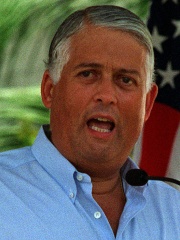
10. Ernesto Pérez Balladares (b. 1946)
With an HPI of 56.63, Ernesto Pérez Balladares is the 10th most famous Panamanian Politician. His biography has been translated into 20 different languages.
Ernesto Pérez Balladares González-Revilla (born June 29, 1946), nicknamed El Toro ("The Bull"), is a Panamanian politician who was the President of Panama between 1994 and 1999. Educated in the United States, Pérez Balladares worked as a banker before becoming part of the government of military ruler Omar Torrijos; in 1989, he also served as campaign manager for the pro-Manuel Noriega presidential candidate Carlos Duque. He was elected president in 1994 as the candidate of the Democratic Revolutionary Party (PRD), in a close three-way race with Arnulfista Party candidate Mireya Moscoso and salsa singer Ruben Blades. Pérez Balladares' term was notable for free-market reforms and the privatization of government services. He also rehabilitated a number of officials from the Noriega years and sought a closer alliance with the United States than the previous administration of Guillermo Endara. Following a failed constitutional referendum to allow him a second term in office, Pérez Balladares was succeeded by Moscoso in 1999. In 2009, prosecutors opened an investigation into charges of corruption dating to Pérez Balladares' time in office. He was placed under house arrest the following year, making him the first former Panamanian president to be arrested, and in October 2010 was charged with money laundering. A judge dismissed the charge against him in April 2011. In February 2012, Pérez Balladares was convicted of slandering comptroller Alvin Weeden by calling him a narcocriminal, and sentenced to a $3,000 fine or a year in prison.
People
Pantheon has 19 people classified as Panamanian politicians born between 1836 and 1963. Of these 19, 9 (47.37%) of them are still alive today. The most famous living Panamanian politicians include Ricardo Martinelli, Laurentino Cortizo, and Mireya Moscoso. The most famous deceased Panamanian politicians include Manuel Noriega, John McCain, and Omar Torrijos.
Living Panamanian Politicians
Go to all RankingsRicardo Martinelli
1952 - Present
HPI: 62.92
Laurentino Cortizo
1953 - Present
HPI: 62.89
Mireya Moscoso
1946 - Present
HPI: 62.10
Ricardo Maduro
1946 - Present
HPI: 58.94
Juan Carlos Varela
1963 - Present
HPI: 58.24
Ernesto Pérez Balladares
1946 - Present
HPI: 56.63
Martín Torrijos
1963 - Present
HPI: 56.40
Nicolás Ardito Barletta Vallarino
1938 - Present
HPI: 54.93
Aristides Royo
1940 - Present
HPI: 53.54
Deceased Panamanian Politicians
Go to all RankingsManuel Noriega
1934 - 2017
HPI: 73.80
John McCain
1936 - 2018
HPI: 73.79
Omar Torrijos
1929 - 1981
HPI: 68.76
Guillermo Endara
1936 - 2009
HPI: 59.50
José Antonio Remón Cantera
1908 - 1955
HPI: 55.88
Eric Arturo Delvalle
1937 - 2015
HPI: 55.66
Jorge Illueca
1918 - 2012
HPI: 54.68
Pablo Arosemena
1836 - 1920
HPI: 54.04
Harmodio Arias Madrid
1886 - 1962
HPI: 53.76
Ricardo J. Alfaro
1882 - 1971
HPI: 49.13
Overlapping Lives
Which Politicians were alive at the same time? This visualization shows the lifespans of the 10 most globally memorable Politicians since 1700.

